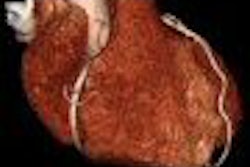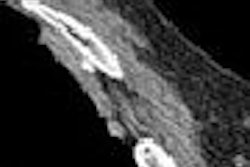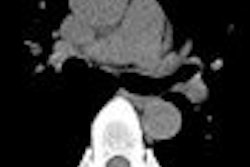With virtual colonoscopy (VC or CT colonography [CTC]) capacity concentrated in the U.S. and Europe, programs to screen Asian populations less invasively for colon cancer have been rare. But Korean researchers say they've duplicated Western screening procedures in a technically advanced CTC program that has examined more than 1,000 asymptomatic patients so far.
Their study, presented at the 2008 European Congress of Radiology (ECR) in Vienna, yielded a high positive predictive value for clinically important lesions, combined with a low referral rate to optical colonoscopy in a cohort of 1,015 asymptomatic adults (609 males, 406 females; mean age of 51 years).
The study design did have some flaws, related to the researchers' efforts to improve the protocol as they went along. During the two-year study period, the investigators switched from a full cathartic bowel preparation to less vigorous purgation, potentially easing the burden for patients but muddying the significance of the results.
"Protocols for bowel prep and scanning changed many times, which is a major limitation of the study," said principal investigator Dr. Sangbu An of Seoul National University in South Korea. During the study period, "a 16-detector-row scanner was used, and we tried to lower the radiation dose," he said. Also, descriptive radiology reports were used for the first 448 exams before the group switched to structural reporting.
"For polyp matching, we tried to translate the descriptive reports into structural reports, and the radiologists and gastroenterologists determined the results of (optical colonography) and CTC in consensus," An said. "Polyp locations within the same or adjacent (colonic) segments and polyp size measurements within a 50% margin of error were considered a positive match."
Optical colonoscopy served as a reference standard in the subset of patients with positive VC results who were referred for the conventional exam.
Following bowel preparation, stool tagging (890/1,066 patients), and automated CO2 insufflation of the colon (ProtoCO2l, E-Z-EM, Lake Success, NY), the subjects were scanned prone and supine on a Brilliance 16-slice CT scanner (Philips Healthcare, Andover, MA). The images were examined on an Aquarius workstation (TeraRecon, San Mateo, CA) in a primary 3D reading with 2D problem solving (966/1,066 subjects).
C-RADS polyp category C0 was assigned to 21 (2.1%) patients, C1 to 916 (90.2%), C2 to 54 (5.3%), C3 to 23 (2.3%), and C4 to one (0.1%). A total of 54 patients with C3 or C4 lesions (n = 21) or C2 lesions (n = 33) underwent subsequent optical colonoscopy, which was completed in 53 of the 54 subjects.
Advanced pathology was detected and histologically proven following optical colonoscopy in 17 of the 1,015 lesions (1.5%), An said. Cancer was detected in four patients, removed by colonoscopy in two patients and surgically in the other two.
As the C-RADS category increased, the positive correlation between optical colonoscopy and CTC increased, and the proportion of neoplastic lesions also increased, An reported.
"For polyps of any pathology, the per-patient positive predictive value (PPV) was 74% and 90% at the C2 and C3 thresholds, respectively," he said. "For neoplastic polyps the per- patient (PPV) was 45% and 70% at the C2 and C3 thresholds, respectively. For polyps of any pathology, the per-polyp (PPV) was 69% and 92% at the 6- and 10- mm thresholds. For neoplastic polyps the per-polyp PPV was 43% and 58% at the 6-mm and 10-mm thresholds, respectively."
The overall VC positive rate was 7.7% of patients, and the optical colonoscopy referral rate was 5.3%, An said. The diagnostic yield for advanced neoplasms was 1.5% (17/1,015).
"These were the first study results of screening CTC in an Asian population using current techniques," An said. "Our test-positive rate, OC referral rate, and positive predictive values were comparable to those of more experienced Western centers, (especially) considering the lower polyp prevalence in our cohort. Therefore the success of screening CTC in Western centers can be reproduced in an Asian population."
By Eric Barnes
AuntMinnie.com staff writer
April 9, 2008
Related Reading
VC with automated insufflation effective in stenosing cancer, March 24, 2008
Automated CO2 insufflation edges patient-controlled air in VC, June 2, 2006
C-RADS reporting yields effective VC analysis, January 9, 2007
VC gets long-awaited reporting standards, November 2, 2005
Panoply of VC studies yields significant extracolonic findings, March 23, 2005
Copyright © 2008 AuntMinnie.com



















